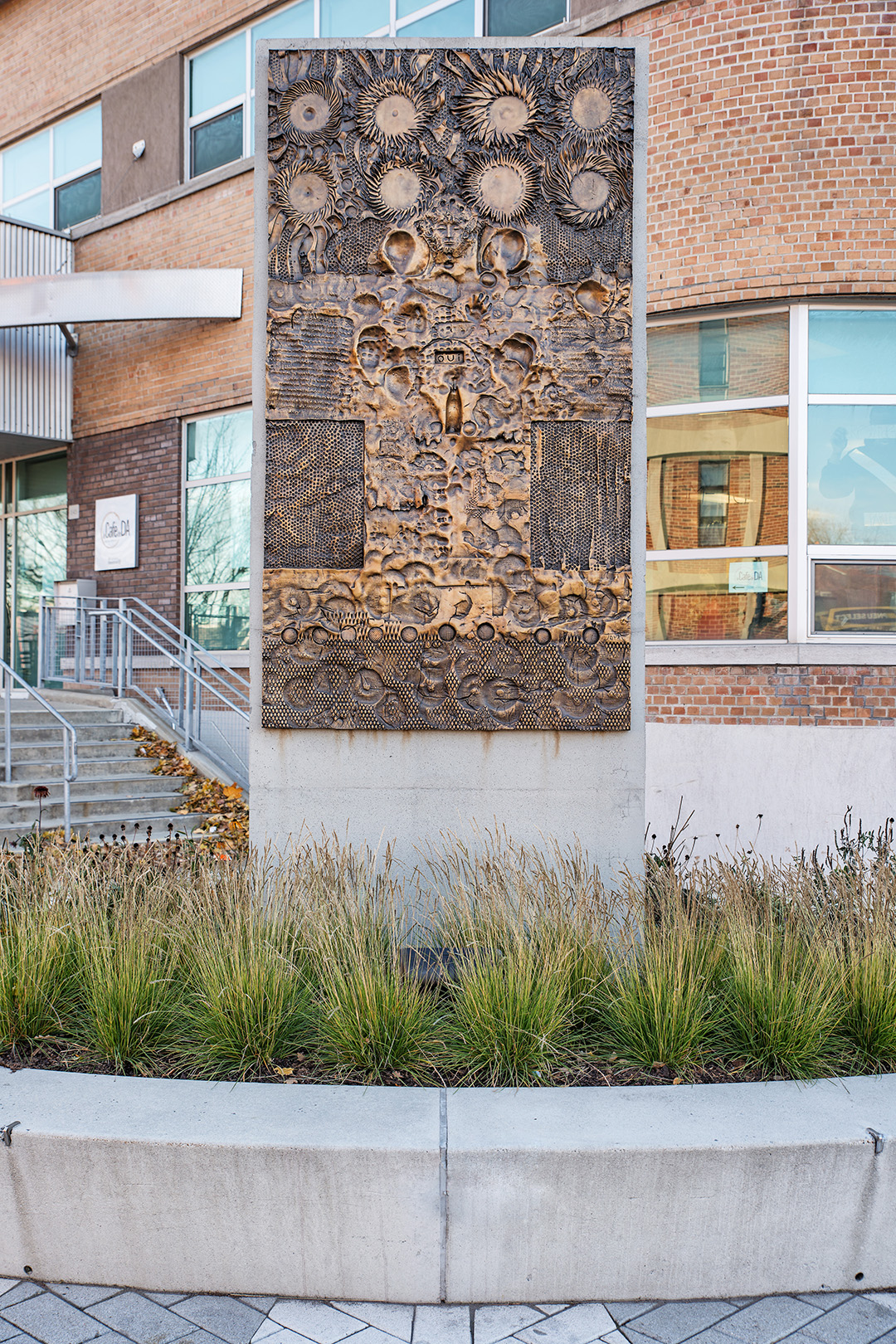Jordi Bonet
L'homme soleil
1975
Presentation of the artwork
L’Homme Soleil is installed on a concrete stele at the corner of Lajeunesse and Fleury streets, in front of Édifice Albert-Dumouchel. Visible to motorists and pedestrians, the artwork highlights the new landscaping for the outside entrance and parvis of Maison de la culture Ahuntsic-Cartierville.The original version of the bas-relief mural was created by Jordi Bonet in ceramics between 1973 and 1975. An edition of eight bronzes was planned, but the artist’s death stopped the project. In 2008, Guy Laliberté (Lune Rouge) undertook to complete the project with the collaboration of Huguette Bouchard-Bonet, the artist’s widow, and offered the fifth copy to the City of Montréal.
Beyond abstract motifs and different textures, figurative shapes are perfectly recognizable to those who look closely: from top to bottom, eight sunflower heads resembling shining suns, a face with closed eyes, a cylindrical form reminiscent of a bottle, two open hands, palms up, and the word OUI (yes, to life, to the world) engraved in a rectangle. The central vertical mass suggests a human body or a tree of life with roots plunging into the ground. The work, more allusive than descriptive, is typical of Bonet’s last period (1973–79), imbued with spirituality and tinged with human resurgence.
Jordi Bonet
Jordi Bonet was born May 7, 1932, in Barcelona. As a child, he lost his right arm in an accident. He studied at the School of Fine Arts in Barcelona, then immigrated to Canada in 1954. Bonet, a designer, ceramicist, muralist, and sculptor, was one of the great Québec artists of the second half of the twentieth century. He produced more than 100 murals in Québec and abroad, including his masterpieces at the Grand Théâtre de Québec, Place des Arts, and the Pie-IX metro station. His works are in Québec museum collections. He died on December 25, 1979, in Mont-Saint-Hilaire.
Presentation of the artwork
L’Homme Soleil is installed on a concrete stele at the corner of Lajeunesse and Fleury streets, in front of Édifice Albert-Dumouchel. Visible to motorists and pedestrians, the artwork highlights the new landscaping for the outside entrance and parvis of Maison de la culture Ahuntsic-Cartierville.The original version of the bas-relief mural was created by Jordi Bonet in ceramics between 1973 and 1975. An edition of eight bronzes was planned, but the artist’s death stopped the project. In 2008, Guy Laliberté (Lune Rouge) undertook to complete the project with the collaboration of Huguette Bouchard-Bonet, the artist’s widow, and offered the fifth copy to the City of Montréal.
Beyond abstract motifs and different textures, figurative shapes are perfectly recognizable to those who look closely: from top to bottom, eight sunflower heads resembling shining suns, a face with closed eyes, a cylindrical form reminiscent of a bottle, two open hands, palms up, and the word OUI (yes, to life, to the world) engraved in a rectangle. The central vertical mass suggests a human body or a tree of life with roots plunging into the ground. The work, more allusive than descriptive, is typical of Bonet’s last period (1973–79), imbued with spirituality and tinged with human resurgence.
Jordi Bonet
Jordi Bonet was born May 7, 1932, in Barcelona. As a child, he lost his right arm in an accident. He studied at the School of Fine Arts in Barcelona, then immigrated to Canada in 1954. Bonet, a designer, ceramicist, muralist, and sculptor, was one of the great Québec artists of the second half of the twentieth century. He produced more than 100 murals in Québec and abroad, including his masterpieces at the Grand Théâtre de Québec, Place des Arts, and the Pie-IX metro station. His works are in Québec museum collections. He died on December 25, 1979, in Mont-Saint-Hilaire.





